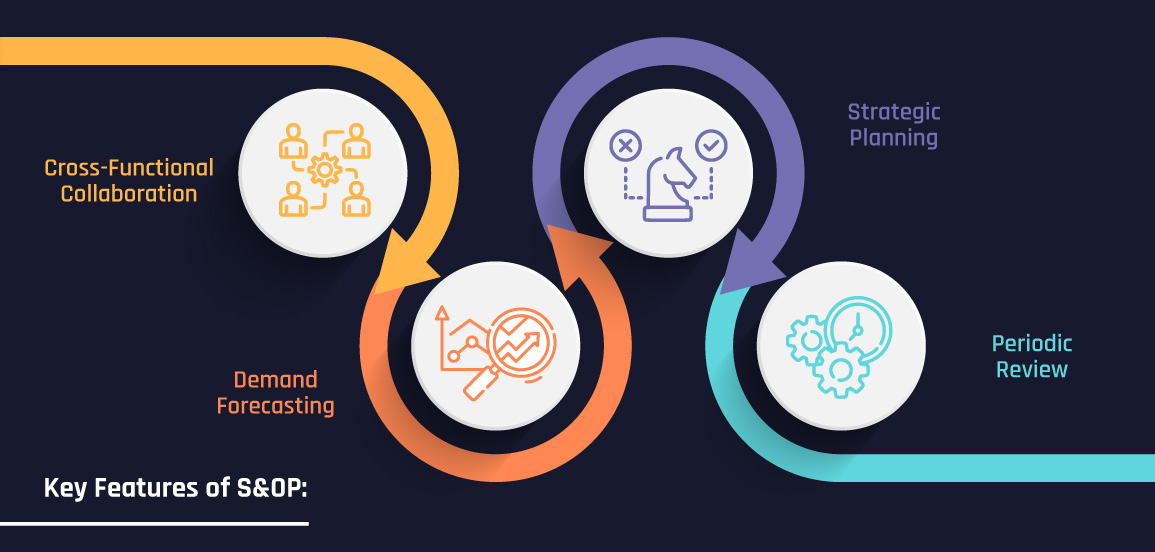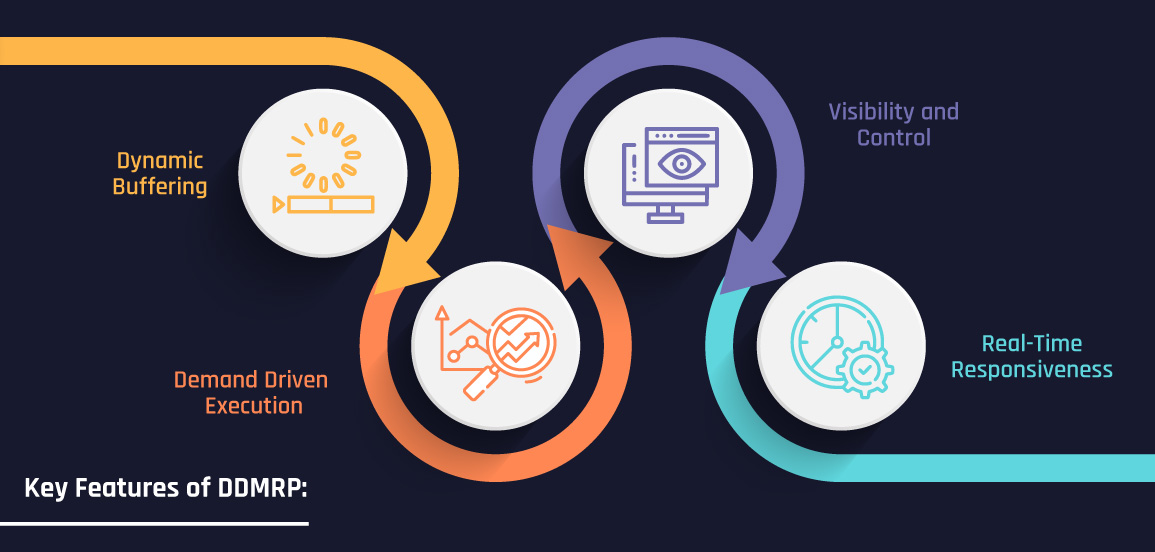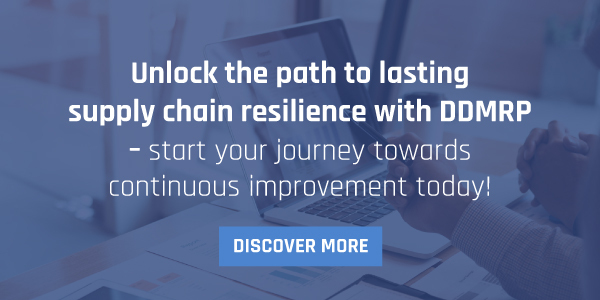
Advanced Metrics for Measuring DDMRP Success: What You Should Track
November 15, 2024
How AI-Driven Insights Enhance DDMRP Decision-Making
December 11, 2024In today’s fast-paced business environment, companies must navigate increasing complexity and uncertainty in their supply chains. Two powerful methodologies—Sales and Operations Planning (S&OP) and Demand Driven Material Requirements Planning (DDMRP)—offer unique advantages for managing supply chain dynamics. However, these methods often are implemented independently from each other, creating missed opportunities for synergy. This article discusses how integrating S&OP with DDMRP can offer a unified and responsive planning approach. By aligning the long-term strategic insights of S&OP with the real-time adaptability of DDMRP, businesses can achieve better demand management, forecast accuracy, interdepartmental collaboration, and agility.
Understanding S&OP and DDMRP
Sales and Operations Planning (S&OP)
Sales and Operations Planning (S&OP) is a structured and collaborative process aimed at aligning an organisation’s business goals with its operational capabilities. This methodology serves as a critical bridge between various functions such as sales, marketing, finance, and supply chain, fostering a unified approach to demand forecasting, resource allocation, and inventory management. By bringing together diverse perspectives, S&OP helps organisations create actionable plans that are both realistic and aligned with their strategic objectives.
S&OP typically operates on a monthly cycle, focusing on medium- to long-term planning horizons. This structured periodic review ensures that the organisation has sufficient capacity and resources to meet projected demand, while also identifying potential constraints or opportunities for optimization.
Key Features of S&OP:
- Cross-Functional Collaboration: One of the most valuable aspects of S&OP is its emphasis on collaboration across departments. By encouraging alignment between sales, marketing, operations, and finance, the process ensures that decisions are informed by diverse insights, reducing silos and improving overall organisational cohesion.
- Demand Forecasting: S&OP relies heavily on historical data, market trends, and predictive analytics to anticipate future demand. These forecasts form the basis for strategic planning, enabling organisations to prepare for fluctuations in customer demand and market conditions.
- Strategic Planning: S&OP aligns business objectives with supply chain capabilities, ensuring that the organisation’s resources are allocated effectively. By identifying gaps between demand and supply, it facilitates informed decision-making on production schedules, inventory levels, and workforce requirements.
- Periodic Review: The monthly cycle of S&OP provides regular opportunities to assess and update plans based on the latest market intelligence, operational performance, and financial projections. This iterative approach ensures that the organisation remains agile and responsive to changes in the business environment.

Why S&OP Matters
In a dynamic and competitive marketplace, organisations must balance customer satisfaction with cost efficiency. S&OP provides the strategic framework to achieve this balance by ensuring that all departments work toward shared goals. By integrating financial plans with operational capabilities, it enables businesses to make proactive decisions that drive growth, enhance efficiency, and mitigate risks.
S&OP is not just a planning process; it is a strategic tool that aligns diverse functions to achieve a common vision, laying the foundation for operational excellence and long-term success.
Demand Driven Material Requirements Planning (DDMRP)
Demand Driven Material Requirements Planning (DDMRP) is a modern supply chain methodology designed to address the challenges of volatility and uncertainty in today’s markets. Unlike traditional planning systems that rely heavily on forecasts, DDMRP prioritises actual market demand, making it a more agile and responsive approach to inventory and production management. By emphasising real-time adaptability and strategic buffering, DDMRP minimises lead times, reduces excess inventory, and mitigates the bullwhip effect—a common supply chain phenomenon where small demand fluctuations at the consumer level cause significant variability upstream.
DDMRP focuses on aligning supply chain operations with real-world demand signals, ensuring that resources are allocated where they are needed most. This method is particularly effective in industries characterised by frequent demand fluctuations, long lead times, or high product variability.
Key Features of DDMRP:
- Dynamic Buffering: Central to DDMRP is the concept of dynamic buffering, where inventory is strategically placed at critical points within the supply chain. These buffers absorb variability in demand and supply, ensuring that fluctuations do not disrupt the overall flow of goods. Buffer levels are dynamically adjusted based on factors such as lead times, order frequency, and demand variability, allowing the system to remain both stable and flexible.
- Demand Driven Execution: DDMRP shifts the focus from forecast-based planning to demand driven execution. Instead of producing or replenishing based on predicted demand, supply chain actions are triggered by actual consumption. This approach significantly reduces overproduction and stockouts, as decisions are made in response to real-time demand signals.
- Visibility and Control: DDMRP provides clear and actionable signals for replenishment and production, enabling better decision-making. Visual tools like colour-coded buffer status indicators offer intuitive insights into inventory levels and priorities, allowing supply chain teams to respond swiftly and efficiently to emerging needs.
- Real-Time Responsiveness: The methodology emphasises adaptability, allowing organisations to adjust plans quickly in response to changing market conditions. Whether it’s a sudden spike in demand or a supply disruption, DDMRP ensures that the supply chain remains agile and capable of maintaining service levels.

Why DDMRP Matters
In an era of increasing complexity and volatility, traditional planning systems often fall short due to their reliance on static forecasts. DDMRP offers a forward-looking alternative that combines strategic foresight with operational agility. By focusing on actual demand and incorporating real-time data, it empowers businesses to reduce waste, improve customer satisfaction, and achieve greater resilience in their supply chains.
The Challenges of Operating in Silos
Both Sales and Operations Planning (S&OP) and Demand Driven Material Requirements Planning (DDMRP) offer significant value to supply chain management, but their isolated application often leads to inefficiencies. When these methodologies operate in silos, organisations struggle to realise their full potential, facing challenges that impact planning accuracy, communication, agility, and data consistency.
- Misaligned Objectives: One of the primary challenges of siloed operations is the misalignment of objectives between S&OP and DDMRP. Traditional S&OP is centred around defining a production plan that meets forecasted demand. In contrast, DDMRP focuses on responding to real-time demand signals, emphasising adaptability over prediction. When these approaches are not integrated, the conflicting priorities can lead to suboptimal decisions, such as overstocking inventory based on forecasts or missing opportunities to meet sudden demand surges due to a lack of responsiveness.
- Fragmented Communication: Another critical issue arises from the differing operational cycles of S&OP and DDMRP. S&OP typically functions on monthly or periodic cycles, offering a strategic view of demand and supply alignment. On the other hand, DDMRP operates in real time, requiring continuous updates and adjustments. This mismatch in timing can create fragmented communication between teams, leading to delays, misunderstandings, and inefficiencies. For example, while the S&OP team may focus on preparing long-term forecasts, the DDMRP team may identify a signal that requires immediate intervention to protect customer service level.
- Data Discrepancies: Data inconsistencies further compound the problem. S&OP and DDMRP often rely on separate data sources and metrics, resulting in discrepancies that undermine trust and decision-making. For example, demand forecasts generated by S&OP may not align with the consumption data used in DDMRP and are often reflecting management wishes rather than realistic market demand, creating confusion about inventory needs and replenishment priorities.
Bridging the Gap: A Unified Approach
Integrating Sales and Operations Planning (S&OP) with Demand Driven Material Requirements Planning (DDMRP) offers a unified approach to planning that combines long-term strategy with real-time responsiveness. By aligning their operational cycles, leveraging buffer management, and synchronising demand signals, businesses can optimise their supply chains for agility and efficiency.
Aligning S&OP Cycles with DDMRP Planning
The first step in bridging the gap is to harmonise the timelines of S&OP and DDMRP. While S&OP operates on a monthly cadence to provide strategic direction, DDMRP focuses on daily or real-time adjustments to meet immediate market demands.
- Intermediate Reviews: Introducing weekly or bi-weekly reviews to the S&OP cycle allows organisations to integrate real-time insights from DDMRP into their strategic plans. This iterative approach ensures that S&OP decisions are informed by the most current data.
- Data Integration: A unified data platform is essential to connect S&OP’s forecast-driven metrics with DDMRP’s real-time consumption data. This ensures consistency across planning layers and minimises discrepancies.
- Feedback Loops: Mechanisms for feeding short-term data from DDMRP into S&OP processes are crucial. These loops enable S&OP teams to refine their projections and strategies based on real-time demand patterns.

Leveraging DDMRP Buffers in S&OP
S&OP can integrate DDMRP’s buffer management principles to enhance forecast accuracy and inventory planning:
- Strategic Buffer Placement: S&OP’s insights into market trends and customer behaviour can guide the optimal placement of inventory buffers. By focusing on high-impact areas, businesses can ensure stability across their supply chains.
- Dynamic Adjustment: Regularly updating buffer levels based on S&OP forecasts and DDMRP’s real-time signals enables a proactive approach to inventory management. This reduces overstock and minimises stockouts.
Synchronising Demand Signals
A hybrid system that merges S&OP’s forecast-driven approach with DDMRP’s real-time responsiveness creates a unified demand signal.
- Collaborative Forecasting: S&OP provides a strategic baseline through long-term forecasts, while DDMRP fine-tunes short-term adjustments to align with immediate market needs.
- Unified Demand Signal: Combining forecasted and real-time data into a single demand signal simplifies decision-making and ensures consistency across all planning layers.
Benefits of Integration
Integrating Sales and Operations Planning (S&OP) with Demand Driven Material Requirements Planning (DDMRP) creates a cohesive planning framework that combines strategic foresight with operational agility. This alignment enhances supply chain performance, bringing significant benefits across forecast accuracy, collaboration, and adaptability.
Improved Forecast Accuracy
One of the key advantages of integrating S&OP and DDMRP is the ability to create more accurate demand predictions. By blending S&OP’s medium- to long-term strategic forecasts with DDMRP’s real-time responsiveness, organisations gain a comprehensive understanding of market dynamics.
- Reduced Inventory Shortages: Accurate forecasts enable precise replenishment, ensuring that inventory is available where and when it is needed.
- Minimised Overstock: Real-time data from DDMRP fine-tunes S&OP projections, reducing excess inventory and associated holding costs.
- Mitigated Bullwhip Effect: Combining predictive and reactive planning reduces demand variability upstream, stabilising the entire supply chain.
This improved accuracy leads to better resource allocation, cost savings, and enhanced customer satisfaction.

Enhanced Collaboration
Integration fosters cross-functional collaboration, breaking down silos between departments and aligning their efforts toward common goals.
- Sales and Marketing: These teams contribute long-term market insights to the S&OP process, enabling more strategic forecasting and planning.
- Supply Chain Teams: Using DDMRP feedback, supply chain managers can adjust inventory buffers and replenishment priorities, ensuring alignment with actual demand.
- Finance: With a unified demand signal, finance teams can align budgets and forecasts, resulting in better financial planning and cost management.
This collaborative environment not only improves decision-making but also strengthens relationships between departments, creating a more cohesive organisation.
Increased Agility
An integrated S&OP-DDMRP approach empowers businesses to respond swiftly to changing market conditions.
- Faster Product Launches: Strategic direction from S&OP combined with DDMRP’s responsiveness ensures that supply chains are ready to support new product introductions without delay.
- Proactive Disruption Mitigation: Real-time data allows organisations to anticipate and address potential disruptions before they escalate.
- Dynamic Inventory Adjustments: The integration enables businesses to adjust inventory levels dynamically based on evolving demand and supply conditions.
Implementing the Integration
Successfully integrating Sales and Operations Planning (S&OP) with Demand Driven Material Requirements Planning (DDMRP) requires a structured approach. Organisations must assess their readiness, invest in technology, train their teams, and methodically implement the integration. By following these steps, businesses can achieve a seamless and effective transformation.
Step 1: Assess Organisational Readiness
The first step in the integration process is to evaluate the current state of the organisation’s planning processes. This involves identifying gaps between S&OP and DDMRP and understanding areas requiring alignment.
- Mapping Workflows: Analyse existing workflows for S&OP and DDMRP to identify overlaps, disconnects, and inefficiencies. This helps pinpoint where integration efforts should be focused.
- Reviewing Data Sources: Assess the quality, consistency, and accessibility of data used by both methodologies. Highlight discrepancies and redundancies that could hinder integration.
- Identifying Technology Needs: Determine the tools and systems required to unify the two approaches, such as platforms for real-time data sharing and analytics.
This readiness assessment provides a clear roadmap for integration and ensures that resources are allocated effectively.
Step 2: Invest in Technology
A unified digital platform is critical for bridging the gap between S&OP and DDMRP. Technology facilitates data sharing, enhances decision-making, and provides visibility across planning layers.
Key features to look for include:
- Real-Time Data Analytics: Tools that provide instant insights into demand, supply, and inventory levels.
- Scenario Planning: Software that enables teams to simulate various scenarios and evaluate their impact on the supply chain.
- AI-Driven Forecasting: Advanced algorithms that combine historical data and real-time inputs to improve demand accuracy.
Investing in the right technology ensures that the integration is scalable and sustainable.

Step 3: Train Teams
Educating stakeholders is essential for successful adoption. Training sessions should focus on the benefits of integration, the mechanics of the new processes, and the roles of various departments.
- Cross-Functional Alignment: Ensure that sales, marketing, supply chain, and finance teams understand how the integration impacts their functions.
- Hands-On Practice: Offer workshops and simulations to build familiarity with new tools and workflows.
Step 4: Pilot and Scale
Start with a small-scale pilot project to test the integration. Choose a specific product line, region, or business unit as a testing ground.
- Monitor Results: Evaluate the pilot’s success through metrics like forecast accuracy, lead time reduction, and customer satisfaction.
- Scale Across the Organization: Use the insights gained from the pilot to refine the approach and implement it across the entire business.
The Future of Integrated Planning
The integration of S&OP and DDMRP represents the future of demand planning. As market dynamics grow increasingly volatile, organisations must adopt planning systems that combine strategic foresight with real-time adaptability. By bridging the gap between these methodologies, businesses can build resilient supply chains capable of thriving in uncertainty.
Conclusion
Integrating Sales and Operations Planning (S&OP) with Demand Driven Material Requirements Planning (DDMRP) offers a transformative approach to demand management. This synergy enhances forecast accuracy, fosters collaboration, and enables organisations to adapt swiftly to changing market conditions. By aligning planning cycles, leveraging buffers, and synchronising demand signals, businesses can achieve a new level of operational excellence. The future of planning lies in embracing this integrated methodology to create a more responsive and resilient supply chain.
Integrate S&OP with DDMRP for enhanced planning and seamless execution across your organisation.





